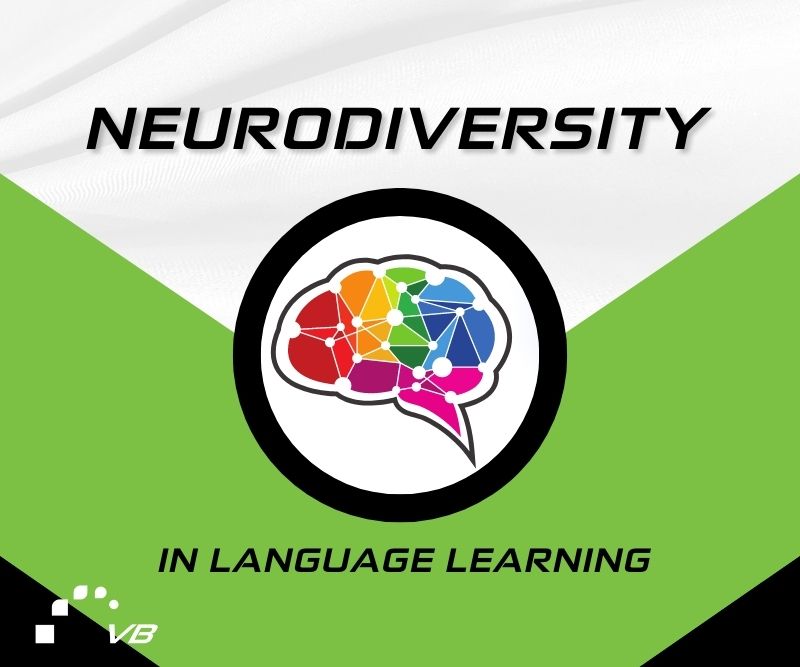
Neurodiversity is a term you may have heard of and wondering what it is all about.
Well, Neurodiversity refers to the general diversity of minds, including neurotypical individuals or perhaps neurodivergent. Neurotypicals are those who have average neurodevelopment and they fit into standards.
Many individuals who are neurodivergent may have a diagnosis or label that you may recognize, for instance, Dyslexia, Autism Spectrum Disorder, or ADHD. But neurodivergent people can be people with different kinds of brain traumas, epilepsy, or just think uniquely without a specific diagnosis required. Overall, Neurodiversity celebrates the fact that there is no “right” way to think. We all have different brains and different ways of interacting with the world around us. And subsequently, different ways to learn as we all have a spectrum of abilities, skill sets, and different approaches to knowledge that will fit our brains’ way of learning.
Neurodiversity has been a very young concept in education historically. The approach has always been one-size-fits-all, without much leeway to adapt to different ways of learning. However, nowadays, there is a more vast awareness of Neurodiversity in the class, and traditional teaching methodologies have, in the past, excluded those who are not neurotypical, hindering many individuals’ learning experiences and ability to achieve their full potential.
At Verbal Bridges, we recognize the importance of Neurodiversity of the language process, and how students are treated throughout their learning experience significantly impacts how they learn a language and achieve their goals. Therefore, we emphasize creating accessible, creative, and inclusive learning techniques. No student is left out. The five points below will highlight how Neurodiversity can impact our language learning and the importance of your language class in having an inclusive approach that will get the most out of the way your brain works to achieve your language goals.
#1 – Intelligence and learning styles
Intelligence levels differ from person to person. And it directly impacts many human behaviors. It is a variable that can be crucial in individual differences and dictate successful learning. Given that individuals have a spectrum of intelligence, this will affect the way they learn something. For instance, if you are highly gifted and have a great photographic memory, you may find certain activities and learning paces very mundane. Therefore, demotivate you, as the learning style does not match the way you process information. Vice versa, you may struggle with memory and retaining information, so a fast past learning environment where information is bombarded. The learning style is not suitable for how you learn. You need a teacher who can really engage with your memory.
On the other hand, the type of intelligence can also be based on age. For example, crystallized intelligence is the ability to use pre-existing knowledge prior to learning. In contrast, fluid intelligence is the ability to learn things very fast without prior knowledge. As adults, due to the wisdom of the years passed, crystallized intelligence will increase, and therefore what does this mean for language learning?
At Verbal Bridges, we recognize different learning styles and multiple intelligences. You can make more accessible mental connections and schematics with your already attained linguistic repertoire to gain new information, such as learning another language. Thus, different learning styles are necessary to adapt to a spectrum of intelligence and capabilities. Research has indicated that applying teaching activities to multiple intelligences can significantly enhance the students’ learning outcomes and promote motivation to learn.
#2 – Language learners don’t always fit into a box
We often hear people throwing around terms when talking about the level in a language, for example, “I speak Greek at a B1 level” or “I’m an A2 in French.” But what does that mean exactly? These are skill levels in the CEFR system and are used to measure their ability in a language. There are six levels: the A levels indicate beginners, the B – intermediate language users, and the C – is advanced. These levels are often used by employers and in academic settings, and indicating your level of language use via these levels can be very beneficial. However, a lot of emphasis is placed on these levels, but the truth is outside the professional or academic realm, CEFR levels are not as important. They’re really only necessary if you want to define where you’re at with your target language.
Additionally, these levels only partially describe language use, as your abilities in a language are also diverse. For instance, you speak B1 French, but your orthography is terrible. Therefore, your written work is that of an A2 user. Language learners are diverse with different abilities. It could be that reading graphic symbols is very difficult for you. But this doesn’t mean it will be the case for your oral comprehension, depending on your abilities dictated by your internal brain makeup.
At Verbal Bridges, we recognize that we might be a B2 on reading but a B1 on speaking. That is why we focus on practicing speaking. Sometimes speaking is the last/ most difficult skill to improve.
#3 – Activities might change as our brain grows
Did you know that learning a language also changes your brain at a physical level?
Everyone’s brain is made up of neurons, which are the connections between neurons; this is what we call gray matter. Bilingual people have more neurons and dendrites than people who speak only one language. Therefore, people learning another language can still benefit from some of the neurological changes that happen to speakers of second languages, no matter their level.
For example, people learn new words and grammatical constructs, making it a very effective brain workout and protecting older learners against dementia and other degenerative neurological conditions. A teacher who embraces Neurodiversity recognizes that as our brain is making these extra connections, our language activities should also change so that we do not plateau in language learning and continue to stimulate our internal mechanisms to get the very most from our language learning.
At Verbal Bridges, we want you to grow. Learning a foreign language with us, your brain will make new neurological connections, and you will definitely benefit a lot from learning a new language.
#4 – Neuroplasticity, different learning paces
As people receive new information and experience unfamiliar scenarios and settings, they actively increase their mental capacities by building brain power, known as neuroplasticity.
Neuroplasticity, also known as neural plasticity or brain plasticity, is a process that involves functional adaptive changes within the brain. Your brain will alter and reorganize synaptic connections as you receive new information and experience new things. From then on, your nervous system will modify its response to intrinsic and extrinsic stimuli by recognizing similar patterns and links. Your brain gets smarter with time and levels up. Neuroplasticity is not a new concept, but awareness of it has been raised on the radars of educators. Recognition of neuroplasticity in the learning environment is essential, as teachers can tap into your brains to maximize the neuroplastic process through their teaching style and curriculum. Learning is the formation of new and stronger neural connections, so putting information in context can aid in this process. Help students tap into existing pathways by making lessons relevant and engaging. Additionally, understanding neuroplasticity can help teachers reach students with different neurodevelopmental conditions, who may have more pathways and will need more time and a different teaching style than neurotypical individuals.
At Verbal Bridges, we understand how the concept of neuroplasticity allows educators to tailor the learning experience to the student’s needs and synaptic connections, an element we very much promote.
#5 – Neurodiversity at work, at school, and in other areas
Diversity of culture, gender, and age can provide any working space with unique opportunities and insight. The same goes for Neurodiversity, as it can be just as important a type of diversity as others, as it can help improve supportiveness for all individuals. In the learning environment, at work, or in other social settings such as a sports team, we come together as a team, which means more Neurodiversity and recognizing that these spaces most accommodate different neuronal needs. Recognizing that individuals have different learning patterns leads to a more supportive environment for everyone and, essentially, a higher chance of the common goal of these groups. It is vital to create a space where the culture of neurodiversity is respected and awareness is raised. This will not only help break stigmas but also foster an environment where all individuals have the same rights, despite different ways of thinking, learning, and adapting.
How would you recognize that Neurodiversity is respected in such spaces? There are many ways, for instance, flexible work location, quiet areas, allowance of sensory toys or fidget toys, headphones available to prevent distraction or overstimulation, offering color filters and font changes to accommodate for different communication and reading styles, frequent breaks, encouragement in collaboration and that the staff has been trained or has some knowledge on adapting for Neurodiversity and common diagnosis of individuals that they may have in their space.
At Verbal Bridges, we see Neurodiversity as a superpower. Use yours to speak a language and contribute to the world in more than one way.
SPEAK BUILD CONTRIBUTE
Used sources:
Medlicott, C. (2022, May 31). Review: Neurodiversity in education in 2022. Ayoa Blog. https://www.ayoa.com/ourblog/review-neurodiversity-in-education-in-2022/
Discussion of teaching with multiple intelligences to corporate employees’ learning achievement and learning motivation. (n.d.). Frontiers. https://www.frontiersin.org/articles/10.3389/fpsyg.2021.770473/full
Changes that occur to the aging brain | Columbia public health. (2021, 10). Columbia Public Health |. https://www.publichealth.columbia.edu/public-health-now/news/changes-occur-aging-brain-what-happens-when-we-get-older
Armstrong, T. (2012). Neurodiversity in the classroom: Strength-based strategies to help students with special needs succeed in school and life. ASCD.
Silberman, S. (2017). NeuroTribes: The legacy of autism and how to think smarter about people who think differently. Atlantic Books.
Kirby, A., & Smith, T. (2021). Neurodiversity at work: Drive innovation, performance and productivity with a Neurodiverse workforce.
Easter traditions in the USA, Germany, and Mexico
People celebrate Easter in many countries and have different traditions
6 Tips to defend your point of view in English
Standing up and defending your point of view might be
International Women’s Day
International Women's Day is celebrated every year on March 8th.






